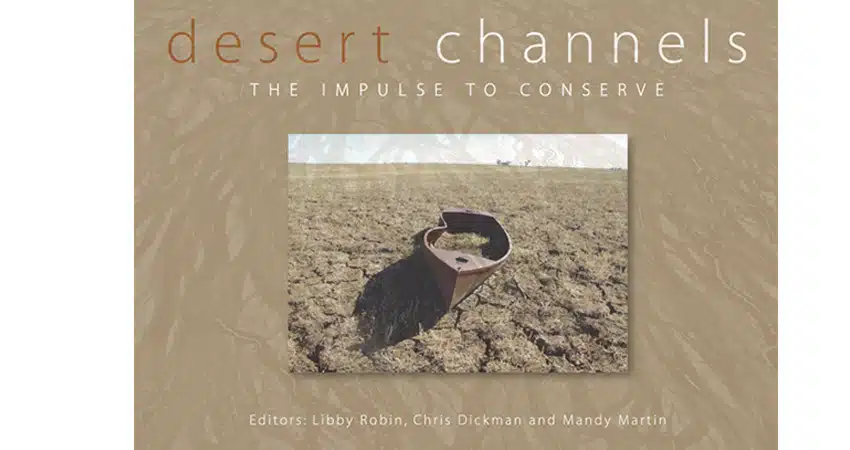 Desert Channels explores the impulse to protect the varied biodiversity of the region, and its Aboriginal, pastoral and prehistoric heritage, including some of Australia’s most important dinosaur sites.
Desert Channels explores the impulse to protect the varied biodiversity of the region, and its Aboriginal, pastoral and prehistoric heritage, including some of Australia’s most important dinosaur sites.
In the interests of sharing the uniqueness of the Channel Country , our production region, we would like to introduce a wonderful book titled Desert Channels: The Impulse to Conserve.
Why the region is so unique
‘The desert channels region is distinctive for many reasons. First, there is the immense scale of the river systems. The catchments of the Georgina, Diamantina, Thomson and Barcoo rivers begin in northern Australia and extend for more than 1000km into central and south-eastern Australia. They feed floodwaters from monsoonal Australia into Lake Eyre, in effect making this playa lake operate as a gigantic continental rain gauge.
Second, the dynamics of the slow movement of floodwater into the heart of the continent, through a variety of sumps and storages, adds another layer of environmental variability beyond that due to fluctuations in local rainfall.
And last, these long channels give the country a distinctive grain – sometimes linear, sometimes reticulate – that is more developed than in other Australian deserts’.
Introduction by Bruce Scott
 Photo of Bruce Scott from Moothandella, a cattle station in Queensland’s Channel Country
Photo of Bruce Scott from Moothandella, a cattle station in Queensland’s Channel CountryThe book was introduced to us by Bruce Scott. Bruce has owned and operated “Moothandella” as a cattle Station in the Queensland Channel Country district for the past 25 years. Moothandella covers an area of 70,000 acres of diverse mixed land systems and drainage areas and is located 43km east of Windorah, on the Diamantina Developmental Road. Bruce was asked to launch the book in Longreach. Bruce’s speech was so memorable that we asked his permission to share it in our blog. ABC Western Queensland covered the launch in an article titled, Book launch: Celebrating the desert channel country.
View a beautiful photo gallery and edited extract in Australian Geographic and here are some photos of the launch.
Bruce’s speech at the launch of the book in Longreach
Ladies and gentlemen,
Desert Channels or the Lake Eyre Basin represents one of Australia’s and the world’s unique and internationally recognised drainage systems. There are very few deltas in the world of the magnitude of the Lake Eyre Basin. Our region has the major river systems that feed it and give it life, filling from the higher and more reliable rainfall areas to the north and east, then eventually terminating in one of the most arid and unforgiving places on earth – the expanse of ephemeral waterholes, wetlands and salt pans of the Strzelecki, Coongie and Lake Eyre.
It is the journey of these rivers, the landscapes they traverse, the lives of people who inhabit the many and different sub-catchments and bio-regions and the wetlands they inundate that has been captured in this book. There is such a richness of culture and nature in the Desert Channels area, it would have been a challenge for the editors to keep it to the size they have.
Desert Channels comprises the geographical region known in historical, mythical, ecological and pastoral terms as the ‘Channel Country’ and Lake Eyre Basin Rivers. The Channel Country and its many watercourses have differing rich meanings for the many diverse and passionate people who contributed to this book. It conjures up thoughts about ancient and evolving cultures, scientists and ecologists, pastoralists and the vast cattle and sheep stations that span across its landscapes for the wider community and the people who may or may not live and work within its invisible boundaries, but are so committed to its continuation, preservation and welfare.
There is so much of Australia’s Indigenous and European heritage intertwined in this unique country’s folklores and traditions. For Aboriginal people the Desert Channels Country was home, a place of feast and famine, their heart and soul, their birth and burial place and a place for their spirit to live.
For the early European explorer it was the place of the mythical inland sea, a possible transcontinental route, a place the earn fame and recognition and a place to die.
For the early pioneering cattlemen and drover it was the new frontier, a place where legends were grown and poems were written, a place of hope and tragedy that became home to some and the downfall of others – a land of boom and bust.
For the scientific ecologists, it is a place that demands complex understandings. They are driven to carefully unlock its habitats and secrets; it becomes a drug, a life’s work and they recognise the importance of protecting it.
To the artist and photographer it is the ultimate canvas and negative: it inspires the mind to do great works and it draws them in like a magnet to its beauty, the majestic diversity in its natural and built environments.
For the contributors of the book, I would like to say thank you for sharing your work, your lives and your interests. I believe it is so special to be asked to be part of bringing this environmental history of research, writings, artworks, photography, experiences and life stories to the wider world.
To have so wonderfully recorded the environmental and economic importance and beauty of this national and internationally acclaimed pristine landscape of Desert Channels is critical to our society’s understanding of what it means to have ‘The Impulse to Conserve’ – and all this represents. We sincerely hope this astonishing publication will be read and understood by many.
While thinking about what to say at tonight’s launch – I went to our copy of ‘Our Channel Country’, one of the powerful books written by one of the Desert Channels’ own daughters, now a well-recognised author of many amazing publications – Alice Duncan-Kemp, whose detailed literary works, Tom Griffiths brings to the surface in this book, based on life and living in this remote and unsettled strange but beautiful land, side-by-side with its Indigenous people.
And in the front and rear flaps of the book, I read the following words, which puts a greater meaning and tribute to this publication than I can ever hope to.
And I quote;
Mrs Duncan-Kemp’s parents were pioneers of the region, and there she grew up, far from any companions except her own family, the stockmen and the Aborigines. In this book she shares with the reader the experience of such a life in such surroundings.
… “The channel country of south-western Queensland is one of the strangest and most fascinating regions in the Australian continent. Surrounded by deserts, by sandhill and gibber country, it is naturally irrigated by a maze of channels fed by the rivers flowing towards Lake Eyre – the Diamantina, the Georgina, Cooper’s Creek – so that in good seasons it blooms like a garden, though with a wild beauty unknown to any garden planted by man.
For some the chief richness will lie in the unfolding pattern in which bird and tree, rock and spring, are interwoven with the life and lore of the Aborigines a pattern known to few white people, and soon to be lost forever. For others it will be found in the work of the cattle station, the movement of stock in drought and storm and flood, the hunting of dingoes and of the mobs of brumbies whose savage leaders abduct the station mares and fight each other to the death. For others again it will lie in the men and women of the lonely spaces, both white and black who made up for the scarcity of their numbers by their individuality and force of character.
And in this last observation about Alice Duncan-Kemp’s works we find a great description of the work of the contributors of this book.
It is fortunate indeed that of the few people who know the channel country intimately there should be one with the sensitive perception and literary skill to recreate it for others. This is not a visitor’s picture, for the author does not only see the country with her eyes, she knows it in nerves and flesh and spirit, as her friends of the ancient tribes know it. Her book has the quality of relation; to read it is to enter another world.”
Ladies and Gentlemen it is my very great pleasure to launch this visually attractive and richly informative publication – “Desert Channels – The Impulse to Conserve”
And I congratulate all that contributed with their works, their time and their financial support.
The book is edited by:
Libby Robin Australian National University (More from this author)
Chris Dickman University of Sydney
Mandy Martin Australian National University
How to purchase this book and related titles?
A hard copy of the book is available for purchase through CSIRO Publishing http://www.publish.csiro.au for AUD49.95
An E-book is available for purchase through www.ebook.com for USD$44.95









